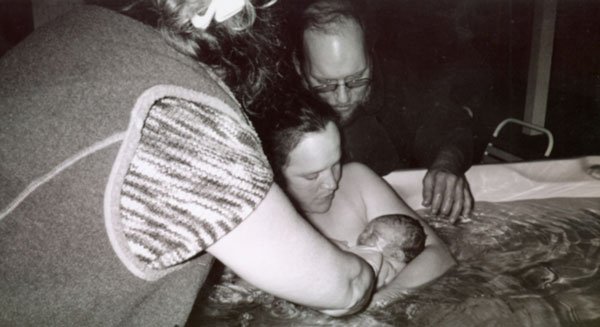At 19 months, Arden Crosier is a force to be reckoned with. The
flaxen-haired Tasmanian devil runs from her mom’s bedroom into the
living room, discarding
”
Goodnight, Moon
”
when she spies one of her toys on a chair.
Her bright red top is mostly a blur that sharpens only when she
runs into furniture, shrieking with delight at the sudden stop.
At 19 months, Arden Crosier is a force to be reckoned with. The flaxen-haired Tasmanian devil runs from her mom’s bedroom into the living room, discarding “Goodnight, Moon” when she spies one of her toys on a chair. Her bright red top is mostly a blur that sharpens only when she runs into furniture, shrieking with delight at the sudden stop. Her hair is thinner along the sides of her head so that at first glance she seems to have a mohawk. And first glance is about all the casual visitor gets during their first 10 minutes as she dashes madly around the room, the one she was supposed to be born in.
This doesn’t look like any birth room that comes to mind. There is no gurney, no monitor, no cold sterility. There’s a plush couch against the window, a beautiful wood-burning stove in the corner (gated off now to protect Arden) and a dog sacked out on the wood floor. Arden has settled, focusing her affection on the butter-colored dog whose head she is patting quietly.
Last Valentine’s Day the couch was covered in blankets, and Hollister resident Annemarie Crosier was nauseously awaiting active labor. But this story really starts months before.
For three-and-a-half years, Crosier and her husband David had been trying to get pregnant.
“We were just doing our thing, and about the time we decided to see a doctor about it, I found out I was pregnant,” said the 33-year-old massage therapist. “I decided to take a pre-natal massage course as a pregnant woman, and one of the things we did was to meet some midwives. There were three or four there, but I met Teri [Calhoun, a Salinas-area midwife] and I instantly liked her and I instantly trusted her.”
Crosier had already been exposed to the idea of a home birth, having read John Robbins’ “Reclaiming Our Health” a few months before. Meeting Calhoun solidified the plan in her mind, but Crosier’s husband, a machinist, remained unconvinced.
“He was very uncomfortable,” said Crosier. “He was more concerned for my health than anything else.”
Crosier decided to leave her options open for her husband’s sake. She and David paid a visit to their local Kaiser in Gilroy.
“It was cold, physically and emotionally,” she said. “You could only have two people in the room with you during the delivery, so that meant I’d have my sister and my husband, but there were other people who wanted to be there for part of the labor. You couldn’t leave the hospital once you checked in, but there was no outside area for me to walk around, and there were no windows in the hallway.
“You’re in one room for labor, one for delivery, and another for post-partum that you have to share with another new mom. For my husband they had a little wooden chair. Labor takes a long time, and there was nowhere for him to rest and relax, nowhere for him to lie down. After my husband saw it, he changed his mind.”
The Crosiers opted to hire a midwife to help them at home, spending $3,500 to accomplish something that would have otherwise been free through their health plan. It may sound like a farfetched concept here in the United States, where upwards of 90% of births are conducted in the hospital by obstetricians. But women in other parts of the world frequently take a different view. In New Zealand and Australia, nearly 60% of babies are delivered by midwives, many of whom practice out of hospital labor and delivery wards. In Norway, hospital birth is an aberration rather than a common practice.
The home birth phenomenon, relegated in many people’s minds to the fringes of counter-culture, has a changing face in the U.S.
The majority of home birth clients are well-educated and simply want to have more control over the birth process according to Calhoun, who counts doctors, nurses, migrant workers and Pebble Beach business owners among her clientele.
“It’s really mother-directed labor and delivery,” says Calhoun, a 30-year veteran of the midwifery trade. “If she chooses to be in her bedroom in front of her fireplace, she can be. If she wants to be in the water and have a water birth, she can. As long as there’s progress and it supports the woman and baby in a safe way, we’ll do it.”
Calhoun assisted in the birth of Crosier’s daughter. Her total labor lasted nearly 24 hours (Calhoun was present for active labor and the delivery).
“I actually got to do most of my labor alone, which wasn’t too different from the hospital,” said Crosier, “But I was at home—I was able to walk around my property, spend some time with my horses. I took hot showers. The hospital was so cold when we visited. It must have been only 70 degrees. At one point I had my wood stove heating the house up to 80 because that’s what made me comfortable.”
Crosier ended up having a water birth, though that was unplanned. “I had prepared my hot tub about three days before to make it safe for the labor process,” she said. “It was only supposed to be there to ease the labor pain. We were all set up for me to have the baby in the house, but when I got to transition, right before it was time to push, I didn’t want to move. The baby’s heart rate was good, so we had her in there.”
Crosier said knowing who would be there also played a large role in her choice to use a midwife. She said her sister’s recent birth experience held a common threat with many massage clients.
“The OB who treated her through her whole pregnancy just happened to not be on call that night,” Crosier said of her sister Robine Jeffrey’s August 10 delivery. “So instead she winds up with some doctor she doesn’t know, who she’s never seen before, barking at nurses and ordering her around.”
Many women who choose home birth are also concerned about the use of invasive medical procedures in hospitals. More than one in four babies is born today via cesarean section, and the number of birth inductions is steadily rising.
“The c-section rate is just enormous in this county,” said Isaiah Meyer, 27, of Santa Cruz. “Just hearing a lot of stories from other people we knew about episiotomies and things like that confirmed what we’d been thinking.”
Meyer, who manages a kayaking store and was also born at home, said other health concerns prompted him and his wife Laura, 30, to have their two-week-old son away from the hospital.
“Laura is severely allergic to latex,” said Meyer. “Even going in to the lab for a test she would react. A lot of decisions in the hospital are made out of fear. We were able to make a lot of choices that are pretty out of your control in the hospital.”
The new parents have encountered surprise from many of their neighbors and acquaintances when they’ve mentioned the home birth.
“This guy who dropped a cord of wood off at the house found out,” said Meyer, “and he was like, ‘You had a baby? Here?!’ As a culture birth and death are really hidden from us. I think it’s shocking for people to think of us having our son here.”
Chiropractor Tina Gagnon, 36, has experienced similar reactions. “When a lot of my patients find out that I gave birth at home they go, ‘Oh my gosh! I could never do that! You really felt it was safe?'”
Gagnon, a Morgan Hill resident who had two children at home, said the level of interaction with her midwife made the reassuring difference. Most of her pre-natal appointments were at least an hour in length, as opposed to 15-20 minute hospital visits. And at the birth, “the midwives do the exam right there on the bed in front of you,” said Gagnon.
“In the hospital they whisk the baby away and check it and do tests, and the mom just sort of has to wait,” she said. “I was able to hold the baby immediately. They told us what was going on, what they were looking for as they checked the baby.
“They come back to your house at the 24-hour, one week and six week checks. They check your breast feeding. And they’re not only checking your baby. If the house is messy, they say, ‘Do you have someone to help you?’ They look in the fridge, make sure you’re eating, see that you’re doing alright.”
Still, fear lingers on the American consciousness. Obstetricians were not available for comment according to information officials for both Hazel Hawkins and St. Louise medical center. Crosier’s doctor at Kaiser, originally supportive of her choice for home birth, abruptly told her he could “no longer support her decision” after talking with a college just weeks before her due date.
Calhoun, a certified midwife who is also a licensed physician’s assistant, brings along two assistants and carries some pain medications and labor stimulants just in case they are needed.
“Mom is required to have some kind of back-up plan in case things do happen during the delivery,” said Calhoun. “The intention is to transport well before there’s an emergency—to transfer a well mom and baby who are just in need of attention.”
In Crosier’s case there was some tearing, but many midwives prefer natural tearing to episiotomies, since a natural tear will actually heal faster.
“Teri sewed me up beautifully,” Crosier said.
Gagnon experienced almost no fatigue and was up and around by the next day.
If you are considering a home birth, be sure to study up on the process. Interview prospective midwives to make sure that their practices are in line with your desires.
“I chose a midwife that I thought my husband would connect with, too” said Crosier. “Some are very esoteric while others are more scientific. It depends on what you’re comfortable with.”
Home birth is not for everyone. Those with health risks or unhealthy lifestyles will likely have higher-risk pregnancies and a midwife may be unwilling to take such cases. A hospital-based midwife might present a middle ground if this happens. Talk with your doctor to find out how he or she feels about your choice, and be ready to talk your prospects over with loved ones.















